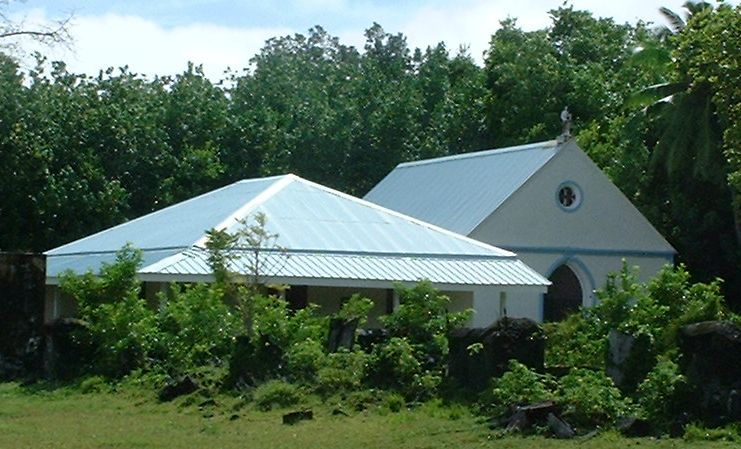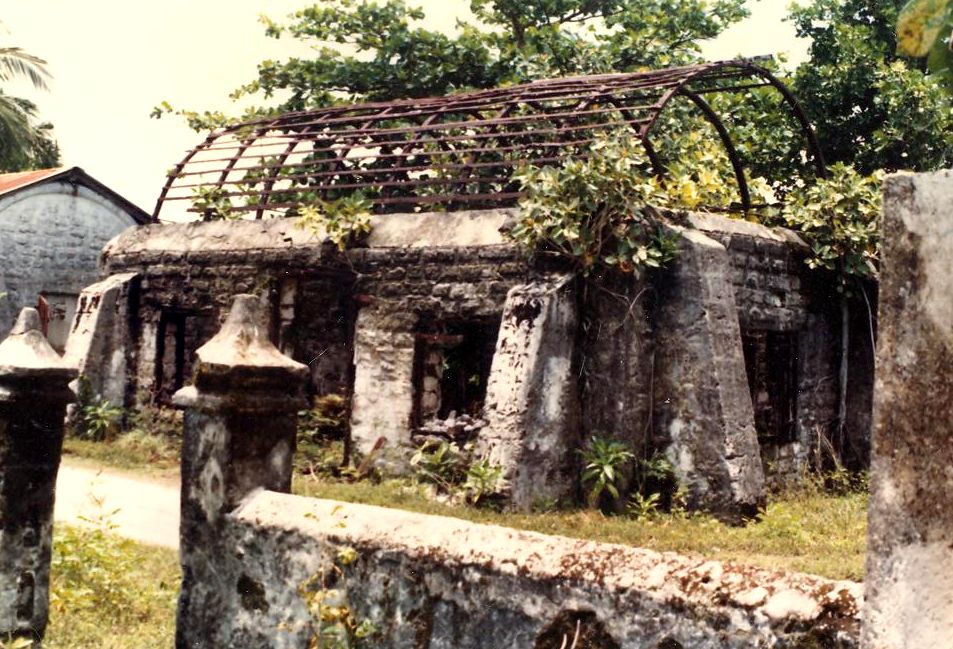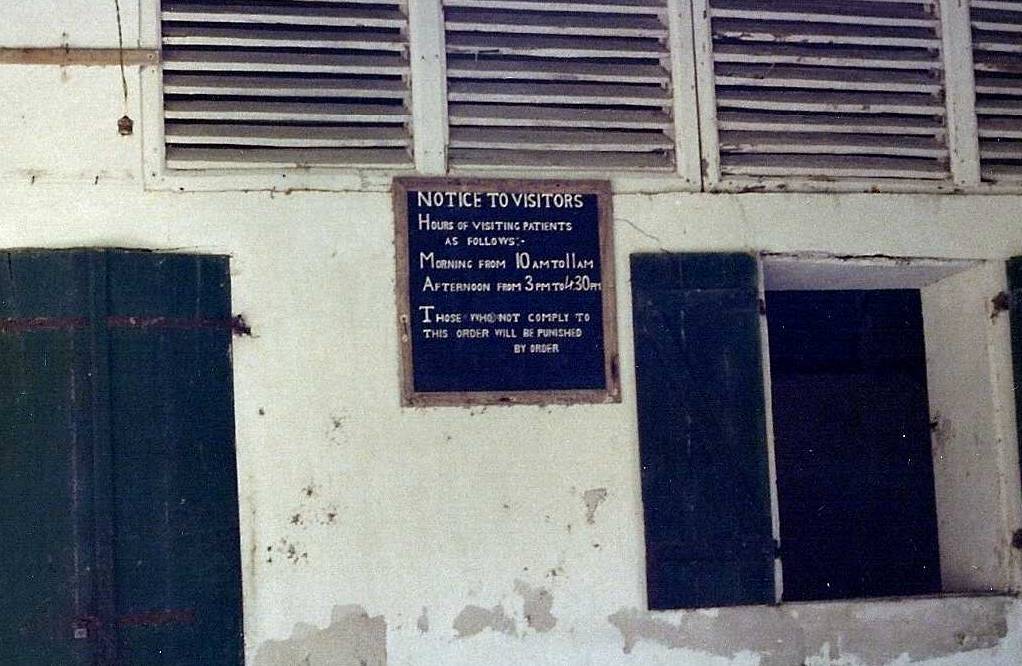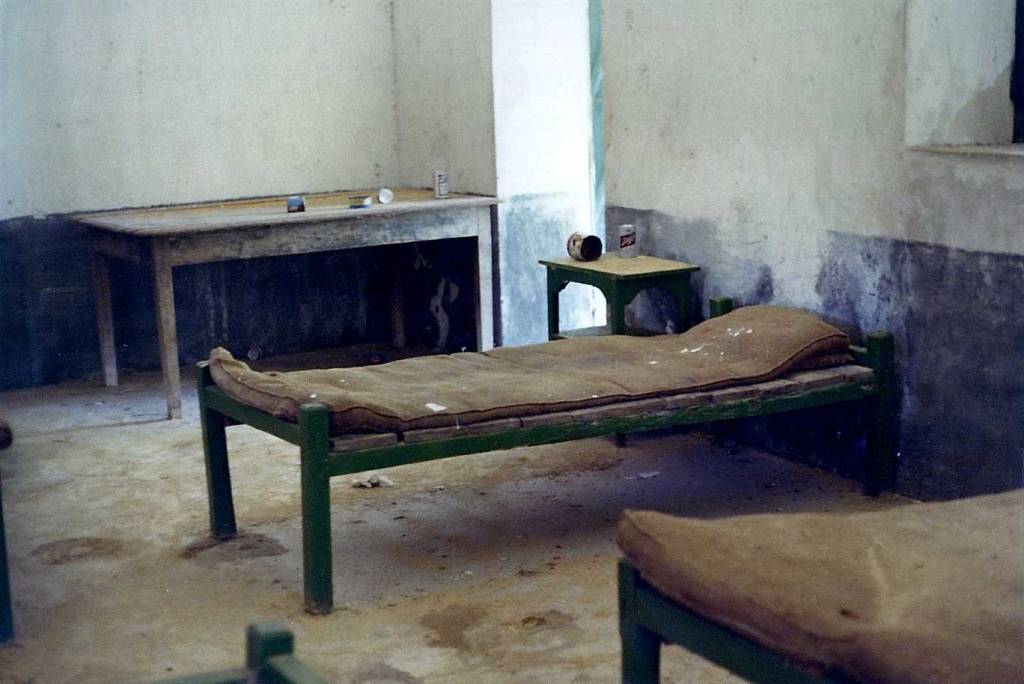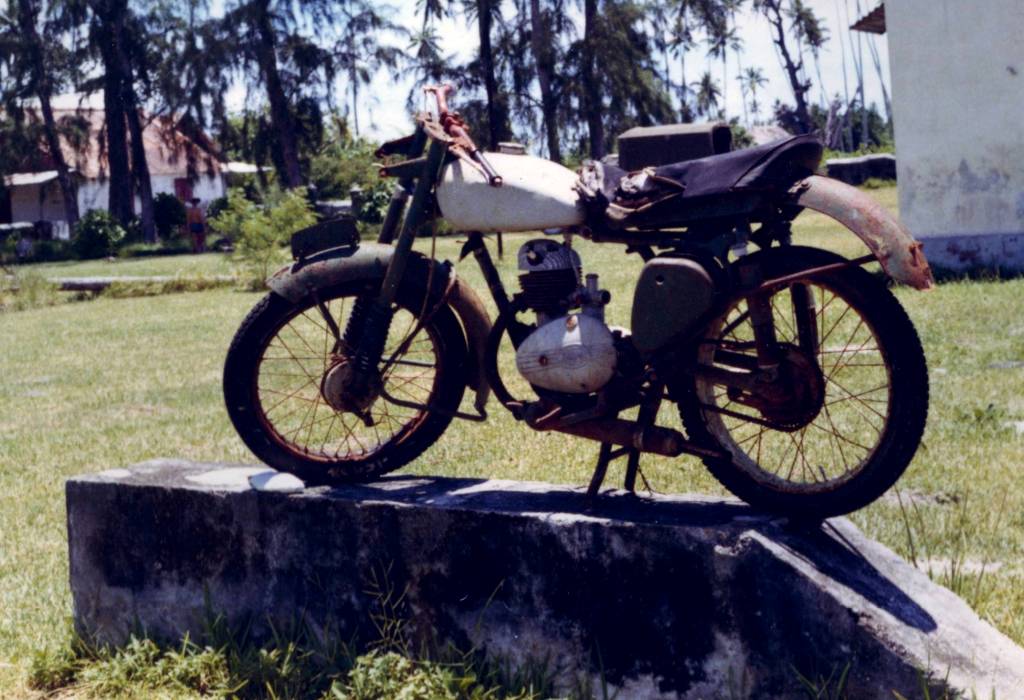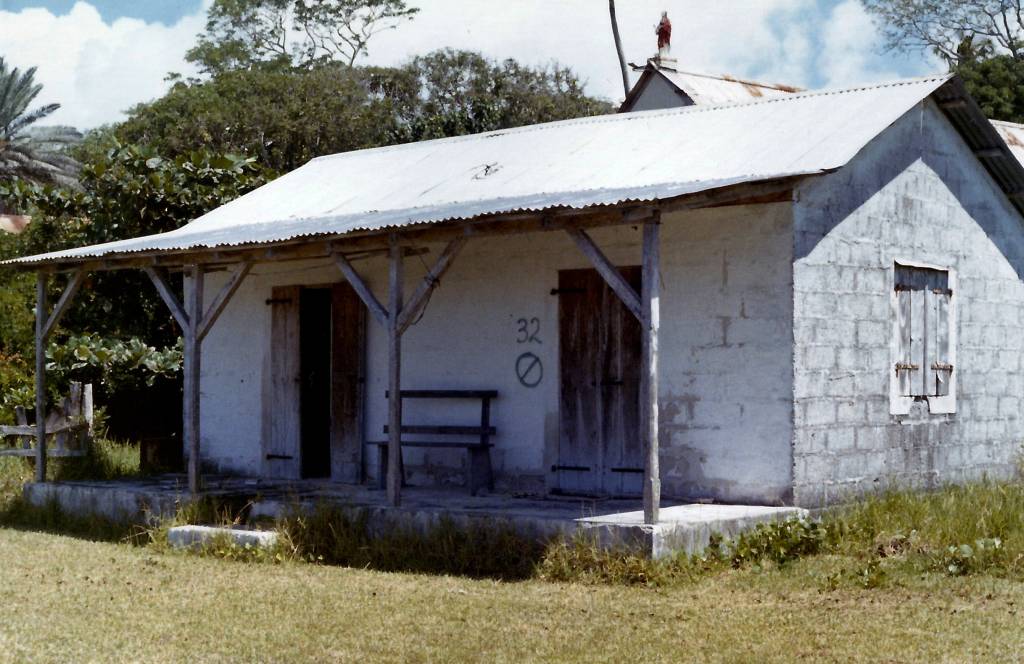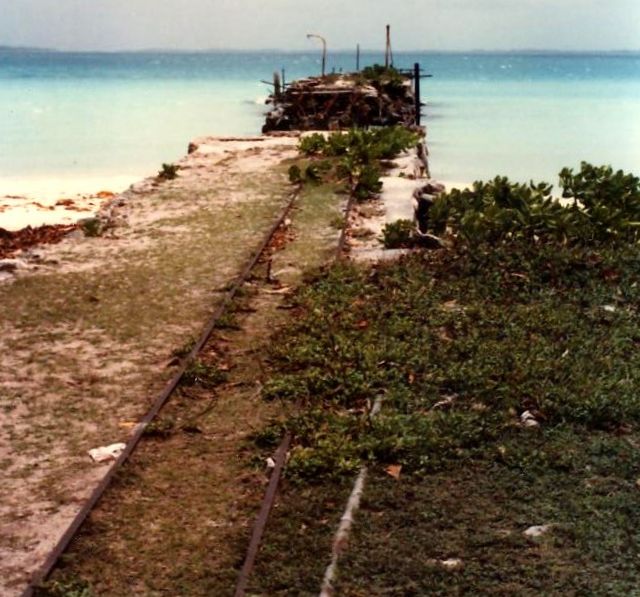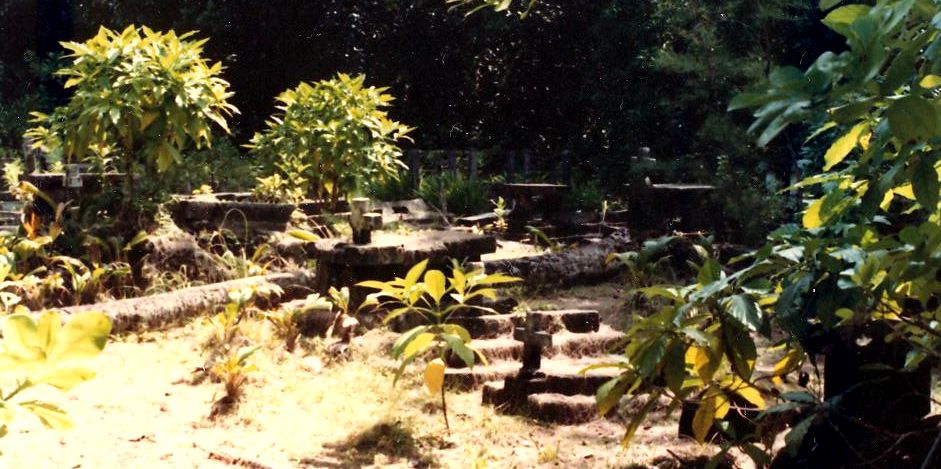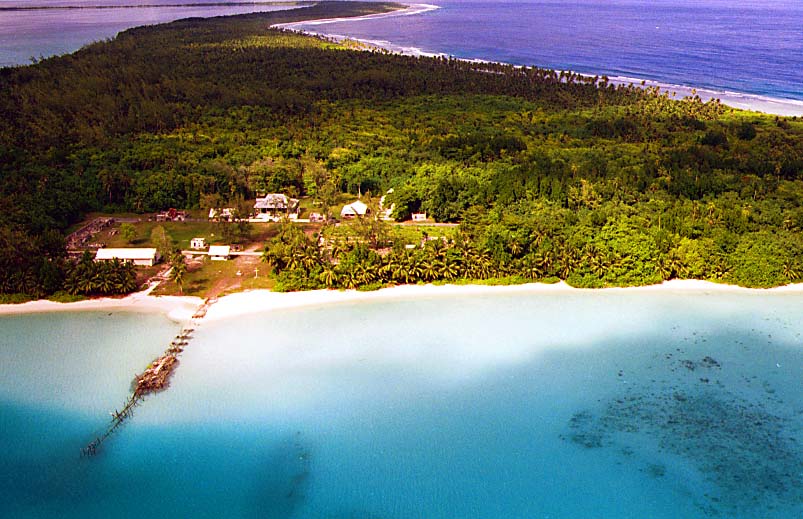The first effort to prepare
Diego Garcia for people was in 1774 when the British
ship DRAKE dropped off pigs, sheep
and goats to propagate for future victualling ships
and maroons. The French dropped off the first
people, marooning lepers from Mauritius there in the
1780s because it was believed that they would eat
the abundant sea turtles, and this would cure their
leprosy, or at least delay the inevitable. The
British tried to establish a "victualling station"
of farms (using 6 ship loads of topsoil imported
from India) in 1786, but the attempt was a failure,
primarily because the East India Company ship ATLAS
wrecked on DG about a month later and the extra 250
mouths to feed doomed the effort. Then, a
Monsieur Lapotaire came out from the French colony
of Mauritius and set up the first plantation on
Eclipse Point in 1793. He brought the first
slaves with him. For those of you who don't
know, Eclipse Point is where the Officers' Club sits
today.
Eventually, the French set up four
plantations: Eclipse Point, Minni-Minni,
Pointe le est (East Point - the "plantation"
everyone goes to visit today) and Pointe
Marianne. There were also several other
small outlying "villages". In 1810, the
British captured Mauritius from the French during
the Napoleonic Wars, and with it Diego
Garcia. By 1838 the Eclipse Point plantation
closed, and in 1840 donkeys were imported because
British law (which freed the slaves in 1834)
forbade using humans to do work that could be done
by beasts of burden. The descendants of
those donkeys remain on the island to this day.
Even so, the islanders were
exploited. As Steve Forsberg notes in his
Masters' Thesis in History, an 1849 article in The
United Service Journal and Naval and Military
Magazine took a very dim view toward the progress
of the islands, whose proprietors “do not
themselves reside in these Islands, but live in
opulence where they like, deputing the management
of the affairs of the Chagos to a number of
registrars, or overseers.” There is
dismay that the laborers “resemble the tribes of
Africa, from whom they took their origin” and that
“No idea of a Supreme Being appears to exist in
the Chagos Archipelago.” After all, the
article points out, the proprietors are of “French
descent." The article states that pigs,
sheep, cows and chickens were everywhere, and that
a "valuable breed of pointers [dogs]" were
raised. It also noted that there sea
turtles, but that "seals and walrus were almost
entirely gone" from the island...
No doubt because of the whaling
ships that lurked in that part of the IO in the
mid 1800s, when the population of Diego Garcia was
in the 300-400s. In 1859 there were 338
souls (258 men, 39 women, and 41 children) and 350
donkeys. Anglican Bishop Vincent, who
visited that year, noted that many of the
inhabitants were Malabars (people from the SW
coast of India). In 1864, the Main House at the
East Point Plantation was constructed, and
plantation records showed 20 Europeans and 358
other inhabitants on the island.
Not that careful official records
were common - government officials from the
British colony of Mauritius visited
infrequently. For example, no official
visited between 1859 and 1875. Missionaries
were few and far between, and seemed to come out
to the island with the government officials - and
leave with them. The aforementioned Bishop
Vincent visited in 1859, stayed for a while, then
left the islanders to their own devices (Sega
Parties, I suppose) until a Roman Catholic Priest
visited in 1875. It wasn't until 1895 that a
church was built on Diego Garcia, but it was
crushed by a falling palm tree in the early 1930s,
and the current chapel at the East Point
Plantation was built to replace it in 1932.
In 1881, the British sent HMS
ECLIPSE to survey the island for use
as a coaling station for the steamboats operating
on the Suez-Australia run. The next year,
two companies set up shop. The Orient Steam
Navigation Company used "hulks" anchored off Minni
Minni Plantation to store their coal, although
they later moved their operation to Middle and
East Islands. W. Lund and Sons, LTD, used
hulks anchored at the East Point Plantation.
The "Coaling Station" period lasted until 1888,
and was marked by wild times, complete with
mutinies by the workers, bizarre witchcraft
rituals in graveyards, wildcat strikes, and even
an invasion by a drunk ship's captain. In
1884 Captain Raymond of the WINDSOR CASTLE
(carrying coal for Lund and Company) gets drunk,
lands at East Point with 16 armed men, takes pot
shots at an unoccupied building he thought was the
Manager's house, nailed a Union Jack on a nearby
palm tree, and claims the (already British) island
for Great Britain. He sobers up two days
later, and sails away. No one else in the
history of Diego Garcia ever got quite that drunk,
except one or two people, maybe once or twice.
In 1883, the three plantations on
Diego Garcia, as well as others on the tiny
islands of the NW Chagos, were bought out by the
Societe Huiliere de Diego et Perhos. The new
company closed the plantation at Minni Minni,
leaving only Point Marianne and East Point as
managerial centers. Remember, the people
lived in small communities around the island, so
there were still people living at Minni Minni, on
Middle and East Islands, and on Eclipse Point.
The first recorded "typhoon" hit in
1901. Although there have been some strong
storms since, one blowing away the US Air Force
Tent City at Point Marianne in 1990, but nothing
rating the name "hurricane". Actually, in
the IO, tropical storms are properly "cyclones".
In the 1700s & early 1800s most
Naval ships calling at Diego Garcia carried
scientists. For example, Captain Moresby of
the [British] Indian Navy visited in 1837, and
some of his observations were used by Darwin in
his books. True scientific expeditions
didn't call on Diego Garcia until 1886 when G. C.
Bourne spent four months studying the natural
history of the island. In 1899, the Germans
arrived and surveyed the marine fauna of the
lagoon. In 1905, the American's showed up
with their Percy Sladen Trust Expedition, and
established that Diego Garcia and the Chagos are
of volcanic origin. In 1967, the British
sponsored a complete hydrographic survey of the
lagoon, as well as carrying D.R. Stoddard and J.D.
Taylor who completed the first book-sized study of
the geology and ecology of the island. There
have been many others in the 2nd half of the 20th
Century, most notable the 1996 Charles Sheppard
expedition that resulted in the book "Ecology of
the Chagos Archipelago".
For all of its isolation, Diego
Garcia has played a role in every war of the 20th
& 21st centuries. One of the most
interesting parts of the history of the Plantation
was that it played host to the German Cruiser SMS
EMDEN, which arrived at the pier on
October 9, 1914. The EMDEN
had spent the preceding 30 days capturing or
destroying allied shipping in the Bay of Bengal
and the Maldives, and shelling the oil storage
tanks at the Indian port of Madras. She put
in to DG to scrape her bottom after a stunningly
successful, and chivalrous, voyage of commerce
raiding. At one point, the EMDEN's
Korvetten Kapitan (Karl Von Muller) released a
captured ship to continue on its way, simply
because there were women passengers on
board. Well, he ran off to DG to take a
break, do some repairs, and refuel from his
collier. The Plantation Manager there, who
did not know WWI had started, helped him get fixed
up, reprovisioned, and on his way, and Kapitan Von
Muller paid handsomely for the services, using
cash captured from British ships! After
leaving Diego, the EMDEN had an
equally successful second cruise, until she met
her fate off Cocos Island, where the HMAS
SYDNEY caught her and shot her to
pieces on the reef (the SYDNEY
stood off with her six-inch guns and the EMDEN
couldn't return fire with her 4.1s).
What's really cool is that the shore party of 50
men, led by the Executive Officer Kapitan-Leutnant
Helmuth von Mucke, which was busily destroying the
Cable and Wireless station on the atoll when the SYDNEY
arrived, stole a yacht, the AYESHA
and sailed to neutral Java, talked their way out
of internment by the Dutch, snuck off in a tramp
steamer to Arabia, and then hiked to Istanbul,
which was the capital of the Ottoman Empire, which
was allied with Germany - the longest Escape and
Evasion in history (it took them seven months, and
many died on the way - most killed by Arabs who
were revolting against the Turks).
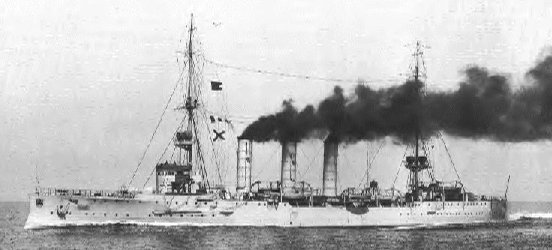
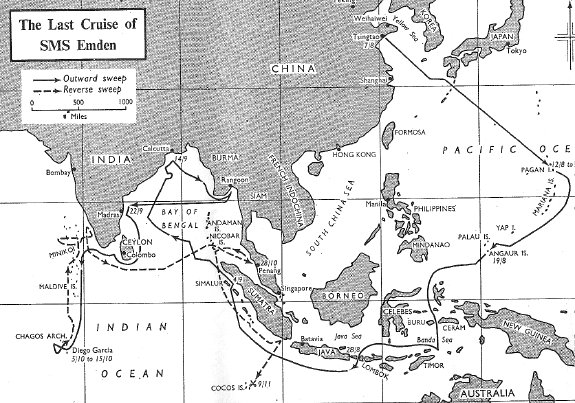
In WWII, the Brits built the gun
positions at Cannon Point in 1942, billeting the
crews at Camp Marcel and Point Marianne, and
established a forward sea-plane base at East
Point. British and Canadian sea-planes were
based there. The UK's military left in 1946,
and didn't return until the Amercans arrived in
1971 (the history since then is detailed elsewhere
in this website).
Throughout all this, the East Point
Plantation was the center of the island
population, until it was closed in 1971.
Here's a map of the island in 1971. Most of
the names are in French, since that language had
been spoken by the workers since they first came
ashore as slaves 178 years earlier.
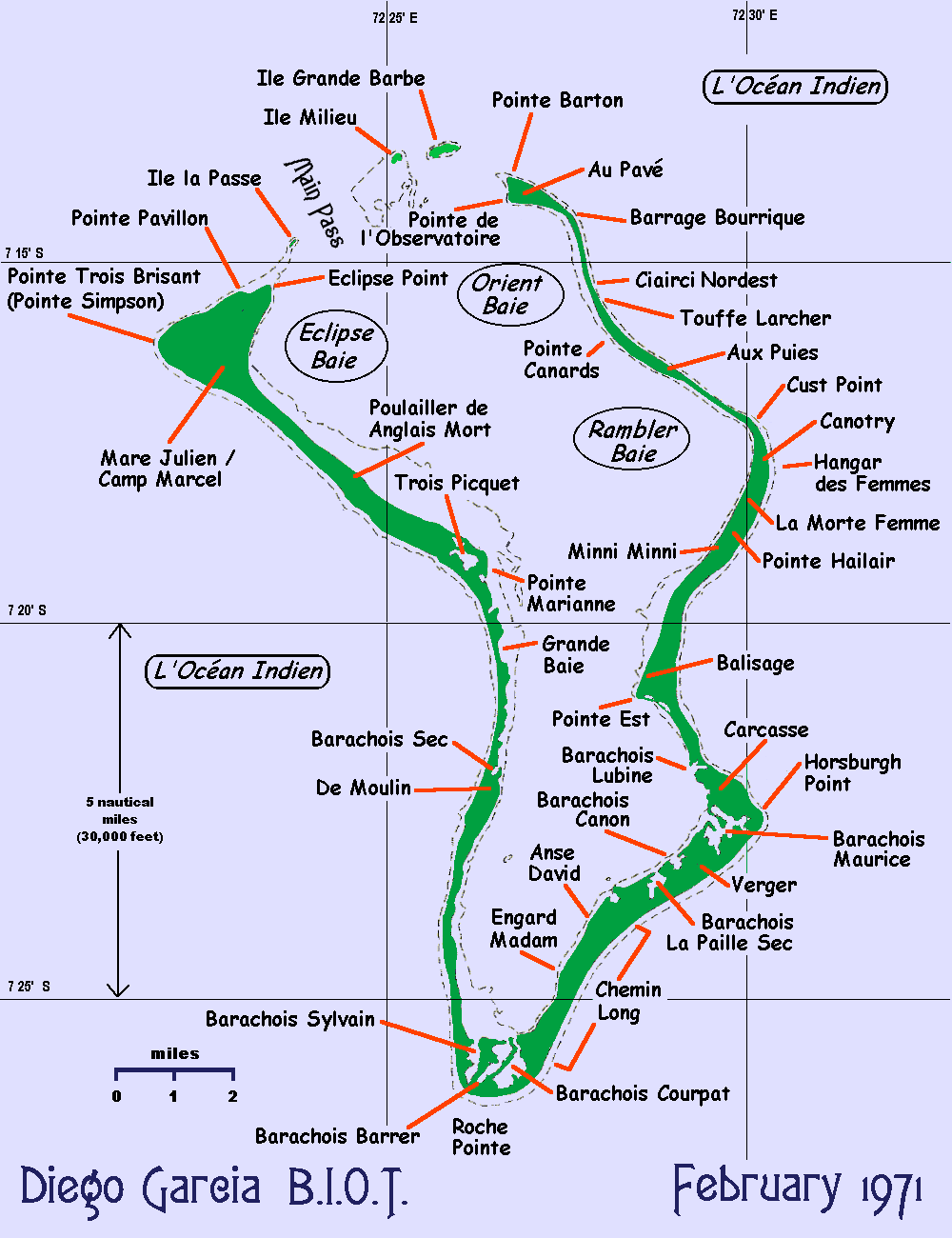
GETTING
THERE
In the late 1980s,
getting to the Plantation was practically
impossible. First you had to get to Diego
Garcia - and only if you were assigned there by
the US or UK militaries, did you have a
chance. For the swabbies and other
Americans living in downtown DG, it meant
getting one of a limited number of permits from
the Brits, then finding somebody with a truck to
take you down there (it was possible to bicycle
down - it was only a 45 mile round trip from
downtown). For the Filipino and Mauritian
workers, it was even harder to work the deal,
and I'll bet there were hundreds of them who
worked on DGAR for years and NEVER got to go to
the Plantation. LOTS of interesting deals
were made in exchange for a trip to the one
place on the island that had any mystique about
it.
One way was to be a
good boy or girl and get awarded "On-Island R
& R". This was a 3-day pass awarded to
"top performers" and others in the good graces
of the honchos. The SEABEES had
refurbished the old Met Office just north of the
Plantation, and turned it into a bunk
house. If you got one of these passes, you
were given a box of food and a ride over to the
place and dropped off for a couple nights.
It was supposed to be a reward, where one was
unbothered by the day to day bullshit of the
military base, but most of the people I talked
to didn't care much for it - no TV, no radio, no
booze, no friends. Here's a picture of the
R&R Center undergoing renovation in
1982. The guy without the shovel
must be the LPO...
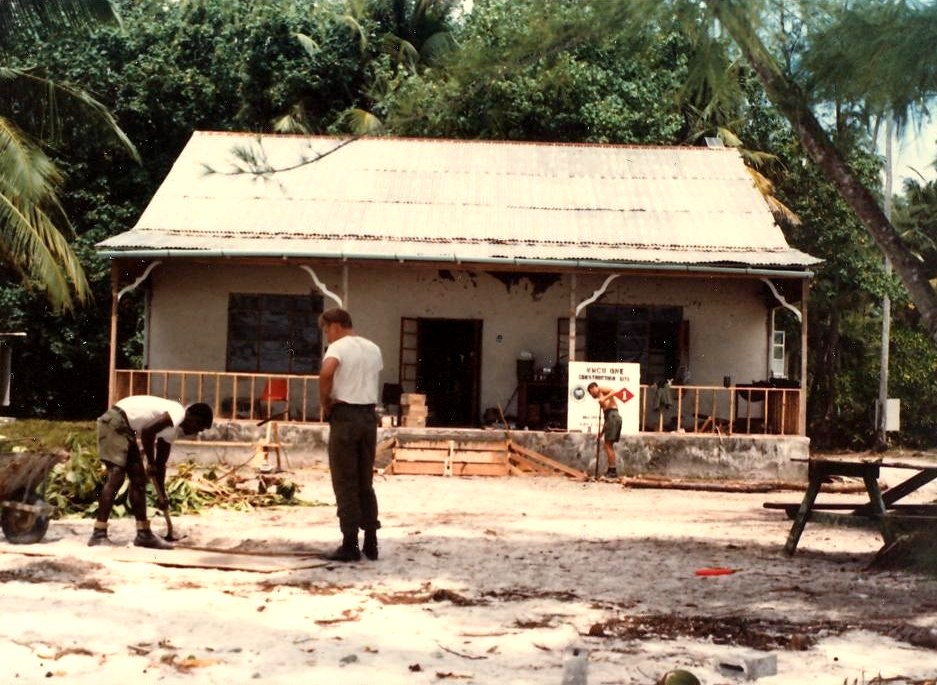
Below: Here's
a photo of the building (which was originally the
Meteorological Station) in 1972, courtesy of Larry
Duran.
Note the baskets in the lower right corner of the
photo, left behind by the plantation workers when
they were evacuated in 1971.
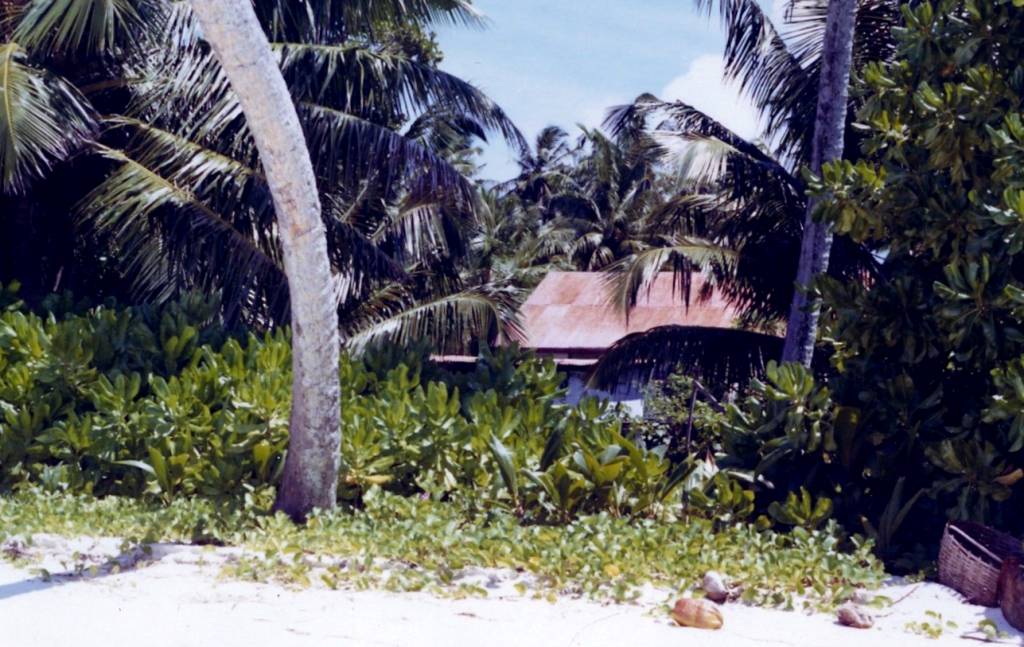
Below:
All there really was to do at the R&R Center
was to try and get Missy drunk.
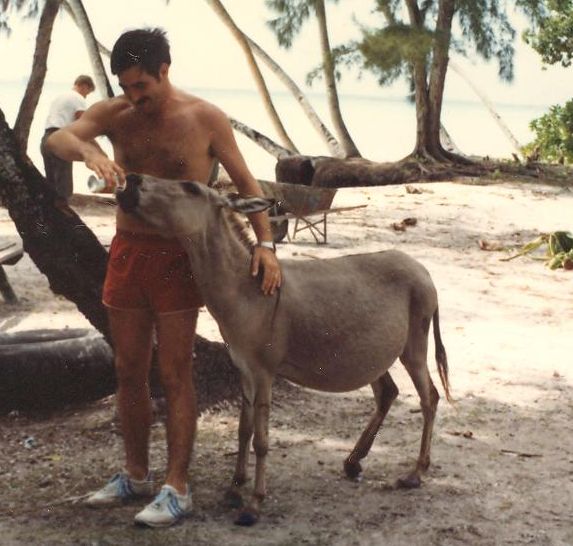

I first visited the Plantation during a
stopover in 1981. Our C-141 had broken
down so we had some time on our hands, and our
loadmaster had a brother in the SEABEES
deployed there at the time. So we
hitched a ride over to the plantation in a
construction van. First we had to change
a tire at the SEABEE work yard, and get some
food from the "Silver Fox" there in
Splinterville.
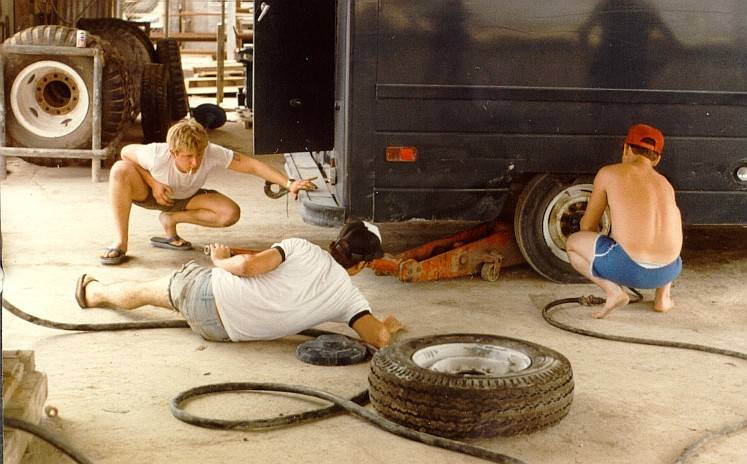
When I was
deployed there myself in 1982, I met an
Australian Naval Officer, Steve Swayne, who as a
member of the British Commonwealth and therefore
didn't need to get a special pass to visit the
Plantation, and we went over there 2 or 3 times,
and strolled the Main Street with
impunity. Of course, it rained. And
rained. And rained.
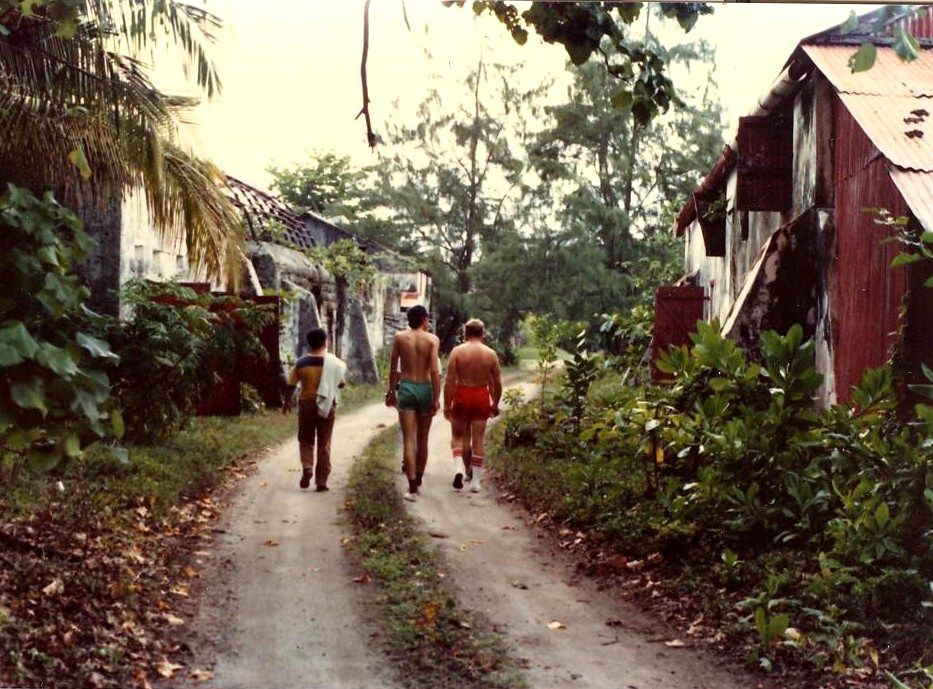
Above -
the "Main Drag" at the East Point Plantation
in 1982.
Below -
Larry Duran's photo of the "Main Drag" taken
in 1972 from approximately the same location
as the one above.
The jungle takes over quickly in the
tropics.
Note the little palm tree on the lower left
and how large it is 10 years later in the
photo above.
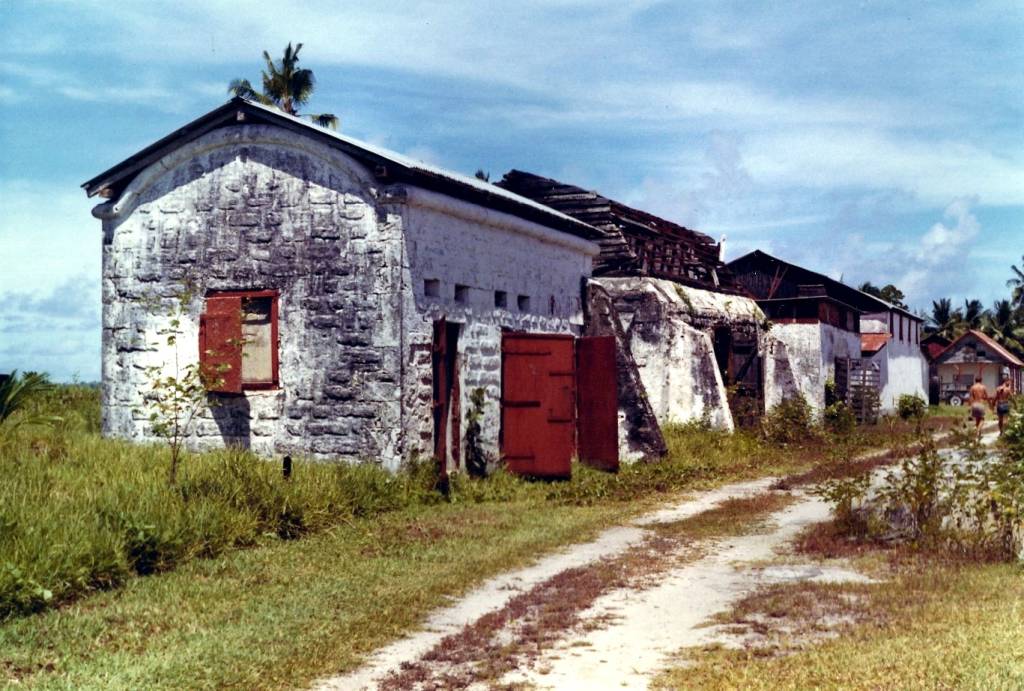

THE
EAST POINT PLANTATION'S BUILDINGS
By 1982, the
Plantation had been abandoned about 10
years, and was in real bad shape.
When I was stationed on DG in 1987-88, the
deterioration was severe, and the US Navy
Chief's Association wanted to do a civic
service project to restore some of the old
buildings. However, the British
Administrator for the BIOT came through on
his annual visit, and told the USN not to
permit it. His reasoning was that
then Mauritians employed as contractors on
the island would take photos of the
restored buildings, and send them to
relatives in Mauritius, where the
newspapers would then print them, and
create more hard feelings by the displaced
Ilois Islanders. Well, now there's
the internet, and no Plenipotentiary
Minister is able to stop the free flow of
info and photos because it might be
embarrassing to one government or the
other! Its also apparent that his
decision was reversed sometime in the near
distant past, as these "before and after"
photos show.
The
"Master's House" at East Point
Plantation, 1945:
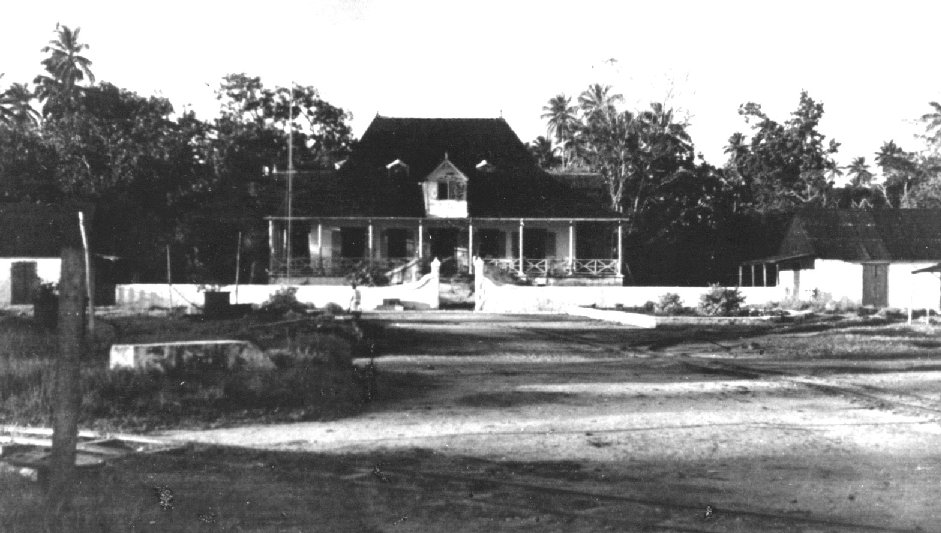
Below - Larry
Duran's photo of the Manager's House
taken from the beach in 1972.
The civilian population on DG had been
relocated about 6 months previously.
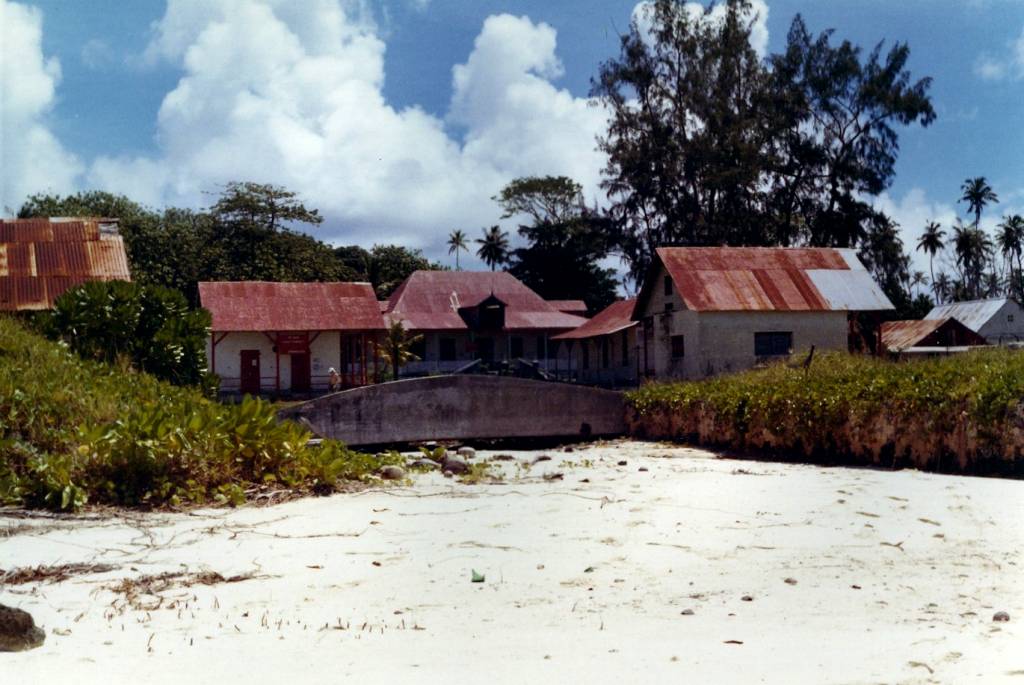
Below:
The Manager's house in 1987
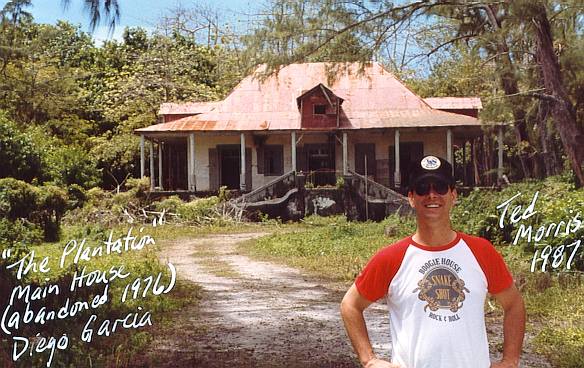
Below: The
Manager's house in 2002 (photo by
Bob Ralph), following
a spruce-up by the NSF Chief's
Association.
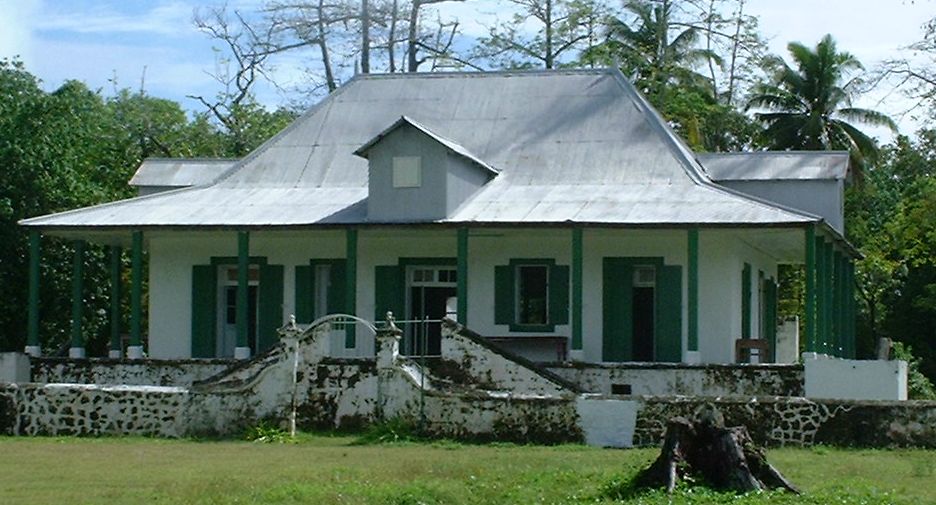
Below: The huts the workers
lived in. Photo from 1972 by
Larry Duran.
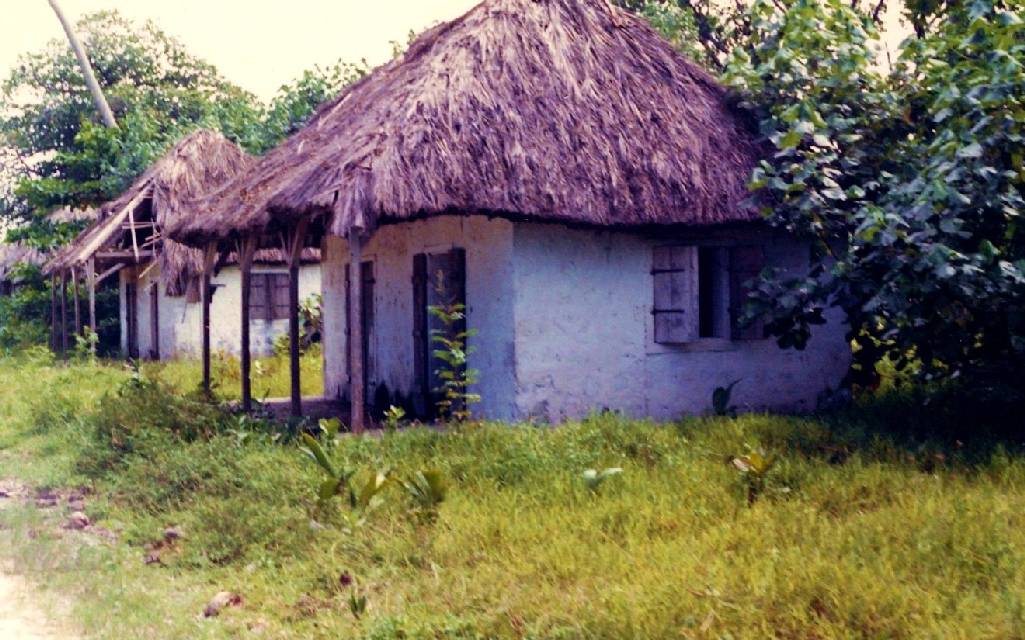
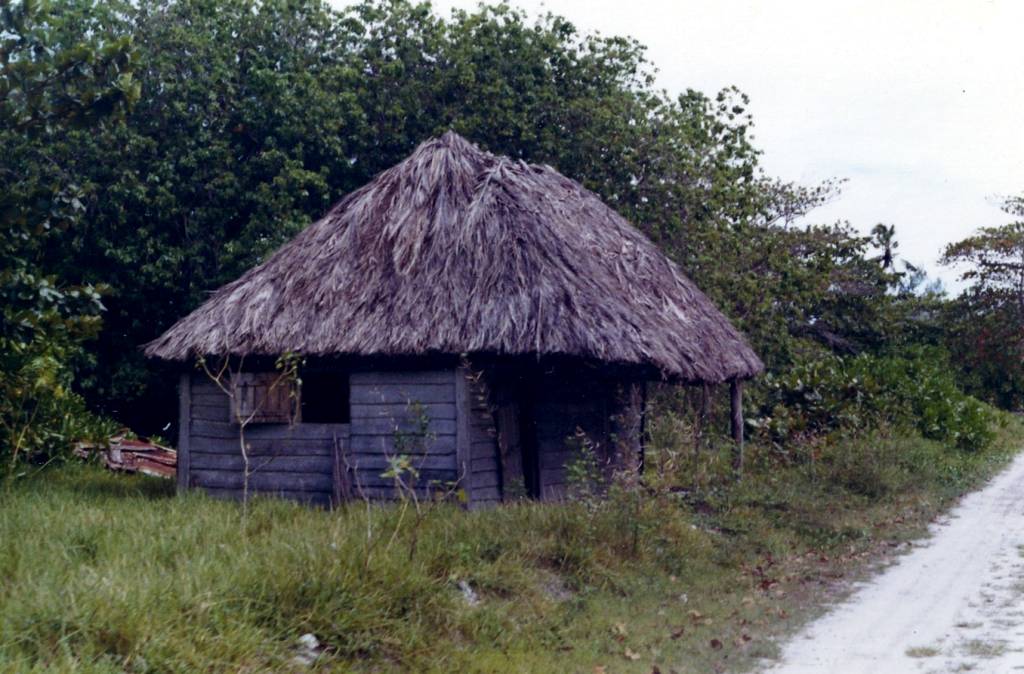
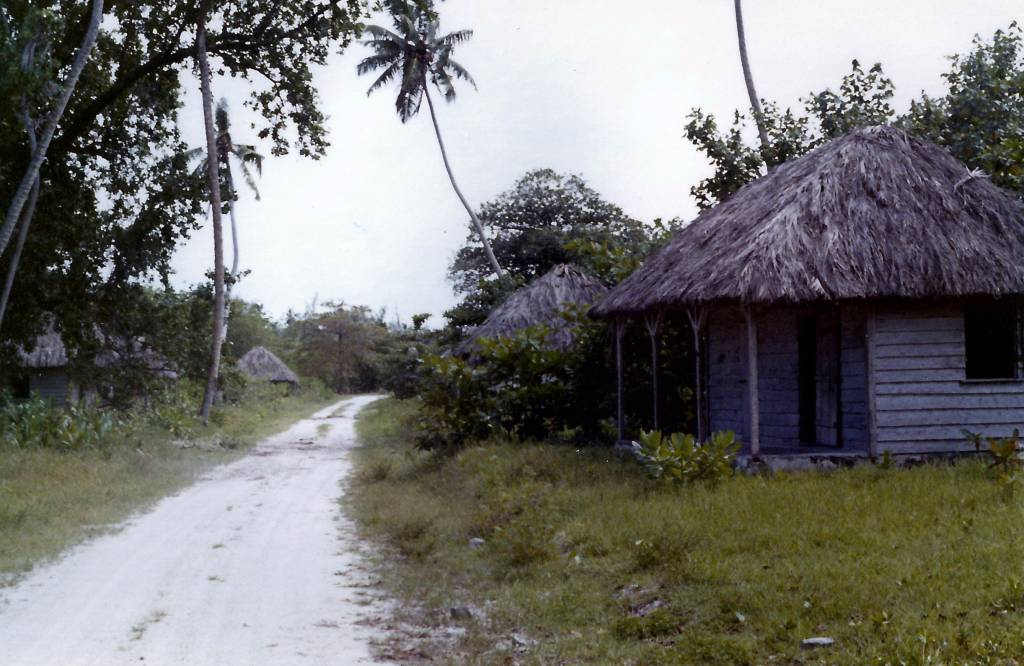
Below:
The Chapel at East Point Plantation,
1946.
Nobody kept
it up in those days - organized
Christianity never was a big part of
Diego Garcia's Plantation era, unless
there was a missionary on the island -
Father Dussercle, a Catholic Priest, was
there from 1933 into WWII, but gave up
and moved away because the British
troops didn't cooperate with his
theocratic rule, and the Chapel went to
ruin.
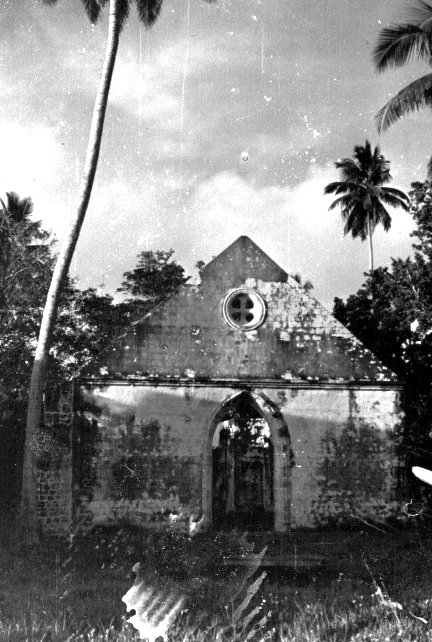
Below:
The Chapel at East Point
Plantation, 1972.
Larry Duran
took these photos of the Chapel
in 1972, just a few months after the
plantation was evacuated:
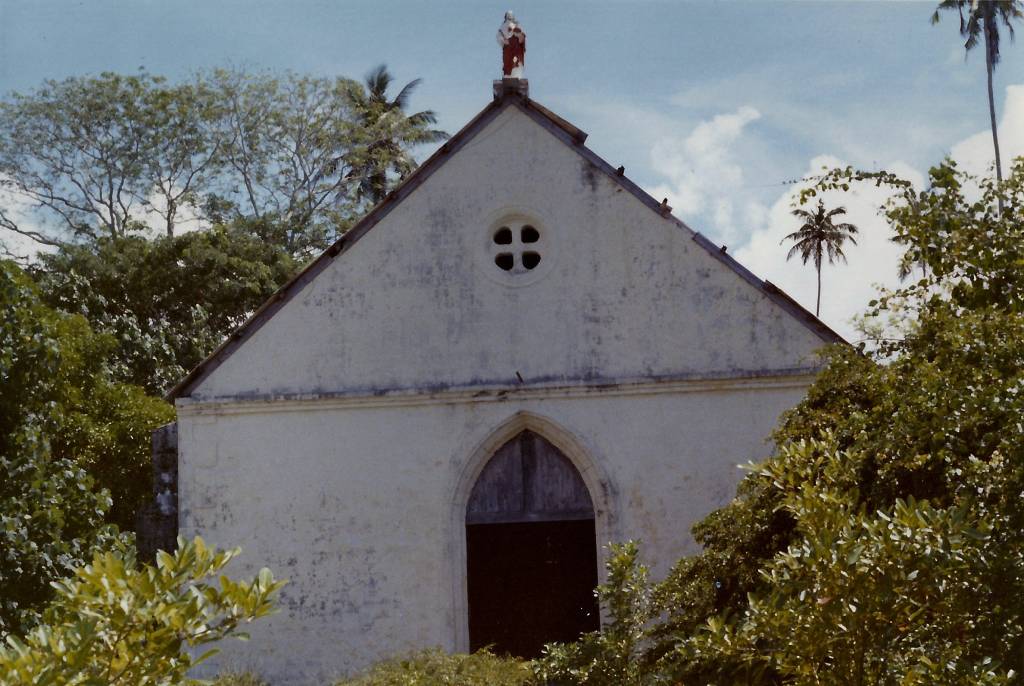
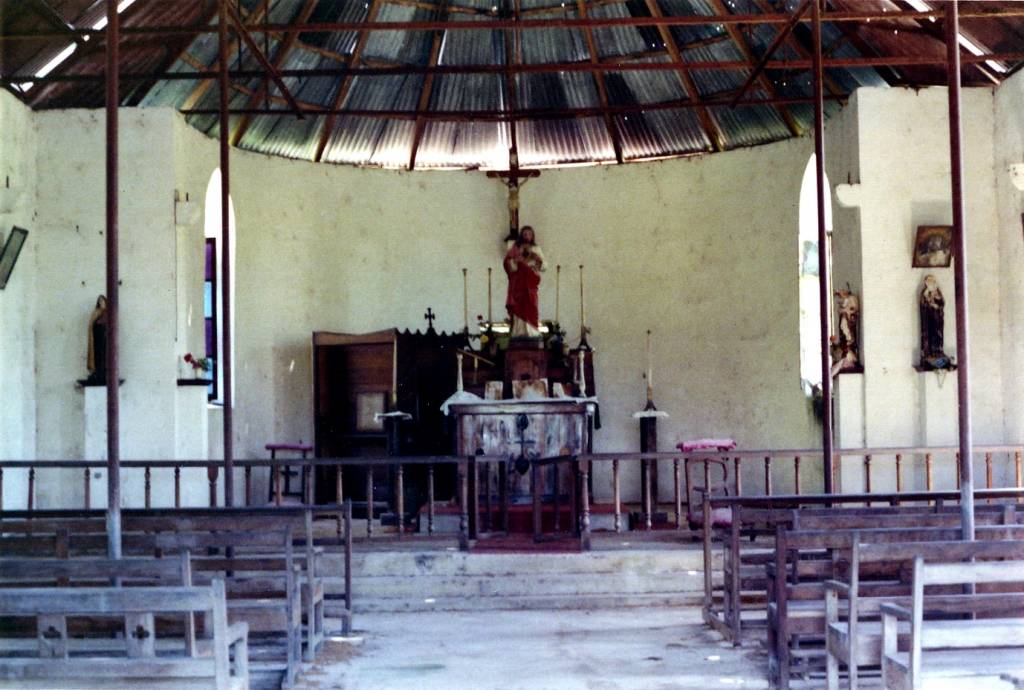
Below:
The Chapel at East Point Plantation,
1982
It had been fixed
up prior to the closure of the
Plantation in 1972. When I took
this picture, there was still a
confession box and holy water basins
inside, but the roof was a sieve and
everything was moldy and rotten from the
100 inches of rain that fell annually.
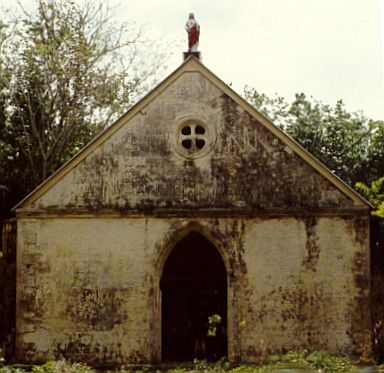
Below:
The Chapel at East Point
Plantation, 2002
